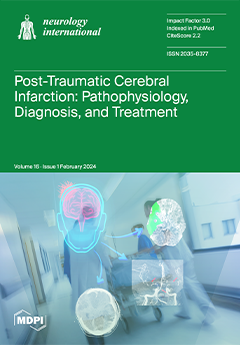Open AccessArticle
Longitudinal Neuropsychological Assessment of Symptomatic Edema after Subthalamic Nucleus Deep Brain Stimulation Surgery: A Case Series Study
by
Silvia De Ieso, Giulia Di Rauso, Francesco Cavallieri, Daniela Beltrami, Alessandro Marti, Manuela Napoli, Rosario Pascarella, Alberto Feletti, Valentina Fioravanti, Giulia Toschi, Vittorio Rispoli, Francesca Antonelli, Annette Puzzolante, Giacomo Pavesi, Federico Gasparini and Franco Valzania
Viewed by 790
Abstract
Severe non-infectious or non-haemorrhagic brain edema surrounding the electrode represents a rare complication of subthalamic nucleus deep brain stimulation (STN-DBS) surgery. The aim of this study is to report three patients with advanced Parkinson’s Disease (PD) who developed symptomatic brain edema after STN-DBS
[...] Read more.
Severe non-infectious or non-haemorrhagic brain edema surrounding the electrode represents a rare complication of subthalamic nucleus deep brain stimulation (STN-DBS) surgery. The aim of this study is to report three patients with advanced Parkinson’s Disease (PD) who developed symptomatic brain edema after STN-DBS surgery treated with intravenous steroids with a specific profile of reversible cognitive alterations. Patients were both assessed with a comprehensive neuropsychological battery including attention, memory, visuo-spatial and executive tasks. They were also briefly assessed for emotional and behavioural alterations, and for possible limitations in the activities of daily living. Normative data for an Italian population were available for all neuropsychological tests. The patients were firstly assessed before the surgery (baseline) as soon as they became symptomatic for the post-surgery edema and a few more times in follow-up up to ten months. In all patients we observed the resolution of cognitive deficits within six months after surgery with the corresponding reabsorption of edema at brain CT scans. The appearance of post-DBS edema is a fairly frequent and clinically benign event. However, in some rare cases it can be very marked and lead to important clinical—albeit transient—disturbances. These events can compromise, at least from a psychological point of view, the delicate path of patients who undergo DBS and can prolong the post-operative hospital stay. In this setting it could be helpful to perform a brain CT scan in 2–3 days with the aim of detecting the early appearance of edema and treating it before it can constitute a relevant clinical problem.
Full article
►▼
Show Figures






